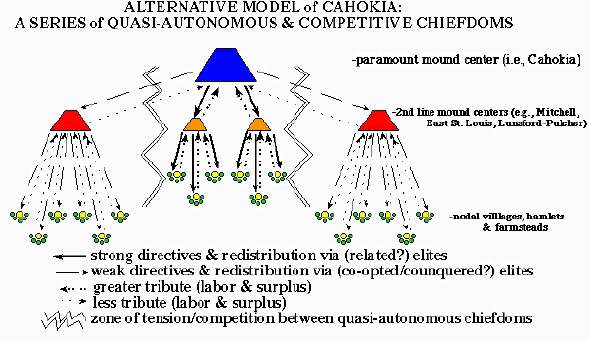Alternatively, the ceremonies and civic activities of villages and towns indicated by mounds, prestige goods, etc., may reflect the power and wealth of largely autonomous elites whose ties to Cahokia were based on common religious beliefs and world views, and not on a universally recognized omnipotence of the Cahokia elite (Milner 1990, 1998; Milner and Oliver 1998).

This conservative, "decentralized" view of Cahokia's socio-political
complexity and power recognizes the following:
- The number of excavated farmsteads, hamlets, nodal settlements,
villages, and mound-towns where simultaneous occupation can be demonstrated
and cultural changes tracked is quite small.
- The dates of construction and abandonment are known for only few
mounds at a few sites. The excavated and well-dated sites show that periods of site occupation were quite varied. Not only were they not simultaneously occupied, their rank of importance was not always the same through time.
- Earlier population estimates of 10,000 to 20,000 people for Cahokia are seriously inflated. Recent population estimates that take into account available land and known periods of house occupation yeild a Cahokia population of less than 10,000.
- Cahokia and a few mound-towns were fortified in the late Stirling
through Moorehead Phases. This indicates that Cahokia was having trouble with its enemies. Because there are no known threats outside of the American Bottom at this time, the fortification of Cahokia suggests an internal conflict.
- The quality of much exotic material is actually poor.
- Many people owned prestige goods, particularly shell, and only the
most important people owned a lot. Nevertheless, the quality of many
finished prestige items owned by the elite, particularly shell beads is
poor. This suggests that marine shell was acquired not by traders from Cahokia, but by down-the-line trading between families and alliances.
Determining which archaeological data validate an interpretation of an all-powerful Cahokia and which data support the interpretation that Cahokia was competing with other mound centers in the American Bottom, is extraordinarily difficult given available information. Nevertheless, clues about the validity of these two interpretations may be revealed through an examination of just how influential Cahokia was outside of the American Bottom. If the Mississippian of the American Bottom represents a single complex chiefdom in which socio-political and religious activities and functions were highly integrated and dominated by the Cahokia elite, we might expect Cahokia's influence to be strong outside the American Bottom as well. Alternatively, limited socio-political, religious, and economic influence may be taken as evidence that integration of chiefdoms within the American Bottom was limited as well.
[Previous] [Next] [Up] [Top]
